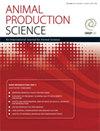血激素浓度作为猪肉产量和品质的标志和预测指标?
IF 1.2
4区 农林科学
Q2 Agricultural and Biological Sciences
引用次数: 0
摘要
激素在非反刍动物肉类产量预测中的适用性尚未得到充分研究。目的探讨血浆中瘦素、雌二醇、黄体酮和胰岛素样生长因子I (IGF-I)浓度对后备母猪肉品产量和质量的表征和早期预测的适用性。方法将150日龄动物与激素中位数浓度低于(“低”)和高于(“高”)的动物进行比较,并对200日龄动物的肉产量和品质性状进行比较。关键结果150日龄血中瘦素浓度高的仔猪屠宰重、胴体重和火腿重高于200日龄低血中瘦素浓度的仔猪,但瘦肉含量较低。与雌二醇浓度较低的动物相比,雌二醇浓度较高的动物胴体重、火腿重和背膘厚度较高,半膜肌电导率较低。高血igf - 1浓度与较高的屠宰重、胴体重和瘦肉含量相关。黄体酮浓度“高”和“低”的动物和肉质特征之间没有显著差异。这些观察结果证实瘦素、IGF-I和雌二醇参与了猪肉产量的上调。此外,他们认为瘦素可以用于表征和预测脂肪的产生,而IGF-I和雌二醇(但不包括黄体酮)可以作为猪生长和肉产量的标记和预测因子。这些激素的血液浓度可以帮助猪的特征和选择肉类生产。本文章由计算机程序翻译,如有差异,请以英文原文为准。
Blood hormone concentrations as markers and predictors of porcine meat production and quality?
Context The applicability of hormones in the prediction of meat production in non-ruminant species has been poorly examined.Aims To examine the applicability of plasma concentrations of leptin, estradiol, progesterone and insulin-like growth-factor I (IGF-I) for characterisation and early prediction of the production and quality of meat in gilts.Methods Animals were compared at 150days of age with below (‘low’) and above (‘high’) median hormone concentrations and their traits of meat production and quality at the age of 200days.Key results Animals with a high leptin concentration in blood at the age of 150days had higher slaughter and carcass weights and weight of ham, but a lower lean meat content at the age of 200days, than did the gilts with a low leptin concentration. Animals with a high estradiol concentration had a higher carcass weight, weight of ham and backfat thickness and a lower electrical conductivity of musculus semimembranosus than did animals with a low estradiol concentration. High blood IGF-I concentration was associated with a higher slaughter weight, carcass weight and lean meat content. No significant differences between the animals with ‘high’ and ‘low’ progesterone concentration and meat characteristics have been found.Conclusions These observations confirm the involvement of leptin, IGF-I and estradiol in up-regulation of meat production in pigs. Furthermore, they suggest that leptin can be useful for characterisation and prediction of fat production, whereas IGF-I and estradiol (but not progesterone) could be both markers and predictors of porcine growth and meat production.Implications The blood concentrations of these hormones could help in characterisation and selection of pigs for meat production.
求助全文
通过发布文献求助,成功后即可免费获取论文全文。
去求助
来源期刊

Animal Production Science
Agricultural and Biological Sciences-Food Science
CiteScore
3.00
自引率
7.10%
发文量
139
审稿时长
3-8 weeks
期刊介绍:
Research papers in Animal Production Science focus on improving livestock and food production, and on the social and economic issues that influence primary producers. The journal (formerly known as Australian Journal of Experimental Agriculture) is predominantly concerned with domesticated animals (beef cattle, dairy cows, sheep, pigs, goats and poultry); however, contributions on horses and wild animals may be published where relevant.
Animal Production Science is published with the endorsement of the Commonwealth Scientific and Industrial Research Organisation (CSIRO) and the Australian Academy of Science.
 求助内容:
求助内容: 应助结果提醒方式:
应助结果提醒方式:


